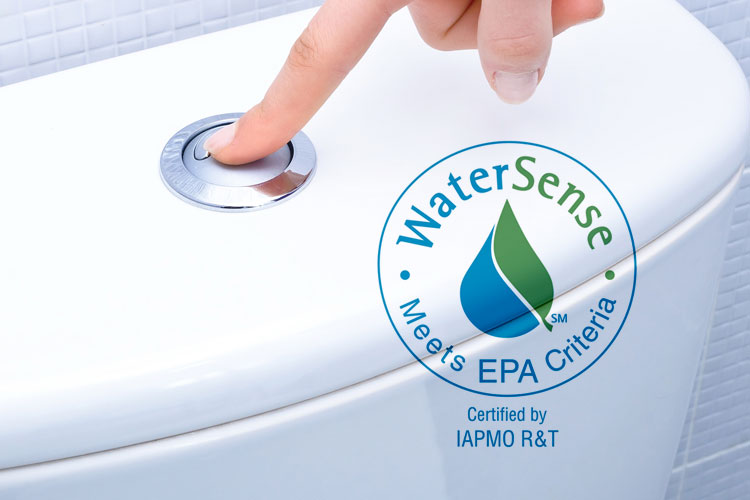Flushometer-valve toilets containing two primary components, a flushometer valve and a toilet bowl, are commonly found in restrooms at such heavily trafficked commercial, institutional or industrial locations as airports, schools, movie theatres, public buildings and sports arenas.
The federal standard for these toilets is a flush volume not to exceed 1.6 gpf. However, of the approximately 26 million flushometer-valve toilets estimated to exist in the United States, nearly seven million are of an older variety with flush volumes ranging from 3-7 gpf.
Single- or double-valve WaterSense-labeled flushometer-valve toilets are certified to use less than 1.28 gpf, which is a 20 percent reduction from the federal standard. They also have a minimum flush volume of 1.0 gpf to ensure an adequate flow necessary for plumbing systems to function effectively.
The design of flushometer-valve toilets has advanced significantly since the 1990s to the extent that their performance meets, and often exceeds, that of residential flush toilets based on EPA testing of more than 320 high-efficiency flushometer valve toilet combinations. In addition, a 2012 Plumbing Efficiency Research Coalition drain line study determined that blockages were not problematic at 1.28 gpf, which was a concern when certification was first being considered.
Replacing older, less efficient flushometer-valve toilets with single- or dual-flush WaterSense-certified products could reduce water use significantly. A 10-story office building with 10,000 occupants, for example, could save around 1.2 million gallons of water and $10,000 in related costs annually.
If every outdated flushometer-valve toilet in every commercial or institutional facility across the country was replaced by a high-efficiency WaterSense-certified toilet, it could conserve nearly 40 billion gallons of water each year.
Certification Criteria
General Water Closet Fixture Requirements
The specification requires conformance with the existing, applicable water closet fixture standards, including ASME A112.19.2/CSA B45.1, ASME A112.19.3/CSA B45.4, and CSA B45.5/IAPMO Z124 when tested with a flushometer valve that has the same rated flush volume.
General Flushometer-Valve Requirements
The specification requires conformance with the existing, applicable standard for flushometer valves, ASSE 1037/ASME A112.1037/CSA B125.37. In addition to complying with the ASSE 1037/ASME A112.1037/CSA B125.37, EPA has established two additional requirements for flushometer valves:
- The flushometer valve’s primary actuator must be a non-hold-open design to eliminate the ability to increase the volume of water released to the water closet fixture by holding the actuator open.
- The flushometer valve must not be adjustable as to its rated flush volume beyond a specified tolerance of 10 percent (i.e., ± 0.13 gpf [0.48 Lpf] for a 1.28-gpf flushometer valve) to limit the degree of flush volume adjustment once a flushometer-valve water closet is installed in the field. The 10 percent tolerance in the specification is intended to balance the desire to maintain water consumption and ensure long-term water savings with the need to adjust the flush volume to facilitate maintenance; account for site-specific differences in water pressures; and fine-tune different flushometer-valve and fixture combinations to achieve maximum performance. The 10 percent tolerance was chosen to be consistent with the allowable variance established under the life cycle test criteria within the ASSE 1037/ASME A112.1037/CSA B125.37 standard.
Flush Performance Criteria
The specification requires flush performance of a single-flush flushometer valve or the full-flush mode of a dual-flush flushometer valve to be tested in accordance with the waste extraction test protocol provided in ASME A112.19.2/CSA B45.1. The specification also requires flush performance of the reduced-flush mode of a dual-flush flushometer valve to be tested in accordance with the flush performance test protocol provided in ASME A112.19.14.
All statistics from US EPA WaterSense website

Anish Desai
Last modified: May 8, 2024

